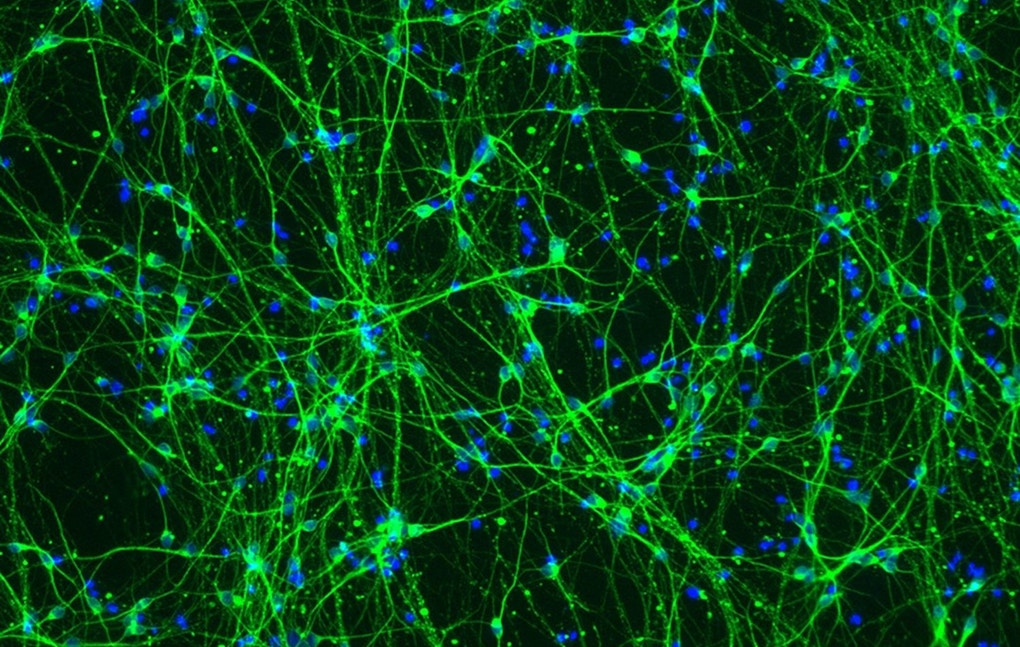
Daniel Schroen, Cell Applications Inc. / Science Source
The Simons Foundation Autism Research Initiative (SFARI) and the Nancy Lurie Marks Family Foundation (NLMFF) are pleased to announce that they joined efforts to generate induced pluripotent stem cells (iPSCs) from blood samples of participants in Simons Searchlight.
With an investment of $450,000 from each organization, SFARI and NLMFF intend to generate iPSCs from 100 individuals over the next year. They plan to possibly generate another 100 iPSCs during a second year of the collaboration. iPSCs will be generated by the New York Stem Cell Foundation (NYSCF) and stored in the SFARI biorepository at Infinite Biologics. Samples will be available for request by researchers worldwide through SFARI Base for a nominal fee.
The first batch of about 30 iPSC lines is estimated to be available in early 2021. It will include lines from individuals with genetic variants in six high-confidence autism risk genes (DYRK1A, GRIN2B, HNRNPH2, SCN2A, SETBP1 and SYNGAP1). SFARI currently estimates that batches of ~ 30–50 iPSC lines will become available every three months, following the first batch. These new iPSC lines will complement the existing SFARI collection of iPSCs that have been previously generated from Simons Simplex Collection and Simons Searchlight participants.
With the advent of high-throughput methods that enable well-controlled, quantitative analysis on a large number of samples in parallel1, iPSCs derived from individuals with genetic changes have become valuable tools for biomedical research. This is especially important for studying developmental brain conditions, where access to tissue of the ‘affected’ organ, the brain, is only possible postmortem.
Due to the remarkable progress in technologies, iPSCs can be differentiated into many different cell types, including neurons and glia2-5, or grown into brain organoids6. By creating a centralized iPSC resource, SFARI and the NLMFF hope to reduce some of the experimental variability introduced when using iPSCs from different providers and often created by using different somatic source cell types or reprogramming methods.
Simons Searchlight provides researchers with clinical data and biospecimens of individuals who are carriers of rare recurrent genetic changes that greatly increase the risk of autism spectrum disorder (ASD) or related neurodevelopmental disorders. Given that the individual genetic events are rare, the data and biospecimens are difficult and costly for any individual laboratory to collect. Likewise, the generation of iPSCs is a highly specialized, lengthy and expensive process. By centralizing the generation of iPSCs derived from Simons Searchlight participants, SFARI and NLMFF will save researchers time and money and will create a technically homogenous resource intended to accelerate research progress. The extensive clinical and phenotypic data associated with the iPSCs lines will also be available through SFARI Base.
“iPSCs are a powerful tool to advance our knowledge of autism biology,” says SFARI senior scientist Julia Sommer. “It is our hope that the generation of these lines will speed up research on the many genetic changes associated with ASD and their impact on brain development and function.”
The iPSCs will be derived from proband peripheral blood mononuclear cells (PBMCs)7 by Sendai virus delivery of reprogramming factors at the NYSCF. Detailed quality control (QC) data (including but not limited to karyotype and pluripotency analysis) will be available on each line. As the reprogramming is organized in batches and it takes six to nine months to generate a fully QCed iPSC line, iPSC lines for the different genetic conditions selected from Simons Searchlight will become available in batches during the next one to two years. At the moment, there are no plans to create iPSCs from the proband’s family members. However, we are considering the generation of isogenic controls for select samples, either by rescuing mutations in samples from individuals with genetic changes or by introducing common mutations in a well characterized control iPSC line.
To stay up-to-date on readily available iPSCs, please visit SFARI iPS cell models resource page.
Requests to order cell lines can be made through SFARI Base.
References
- Hartlaub A.M. et al. Front Pediatr. 7, 57 (2019) PubMed
- Kim D.-S. et al. Front. Cell Neurosci. 8, 109 (2014) PubMed
- Ehrlich M. et al. Proc. Natl. Acad. Sci. USA 114, E2243-E2252 (2014) PubMed
- Tcw J. et al. Stem Cell Reports 9, 600-614 (2017) PubMed
- Douvaras P. et al. Stem Cell Reports 8, 1516-1524 (2017) PubMed
- Arlotta P. and Paşca SP. Curr. Opin. Neurobiol. 56, 194-198 (2019) PubMed
- Zhou H. et al. Stem Cell Rev. 11, 652-665 (2015) PubMed


